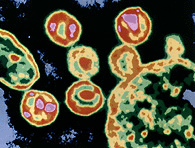 |
 |
 |
 |
|||
 |
||||||
|
Drug resistance and the consequences for treatment HIV is highly variable, it is an RNA virus and the reverse transcriptase has no proofreading function (this means that when the DNA copy is made no checks are made to ensure the sequence is exactly right-mistakes, or mutations, are consequently often encountered). Although some mutations may kill the virus it is inevitable that drug resistant strains will emerge over long term treatment. For example, with continued use of zidovudine, the virus develops resistance to the drug due to mutations resulting in amino acid substitutions in the viral reverse transcriptase. The introduction of potent combinations of antiretroviral drugs (highly active antiretroviral therapy, HAART) has helped to reduce the incidence of opportunistic infections, and improved survival. With HAART, resistance should take longer because a virus strain resistant to one drug could still be sensitive to another. This means that the virus has to develop multiple mutations to overcome the actions of two or more drugs, this is certainly not as likely to occur.
|
